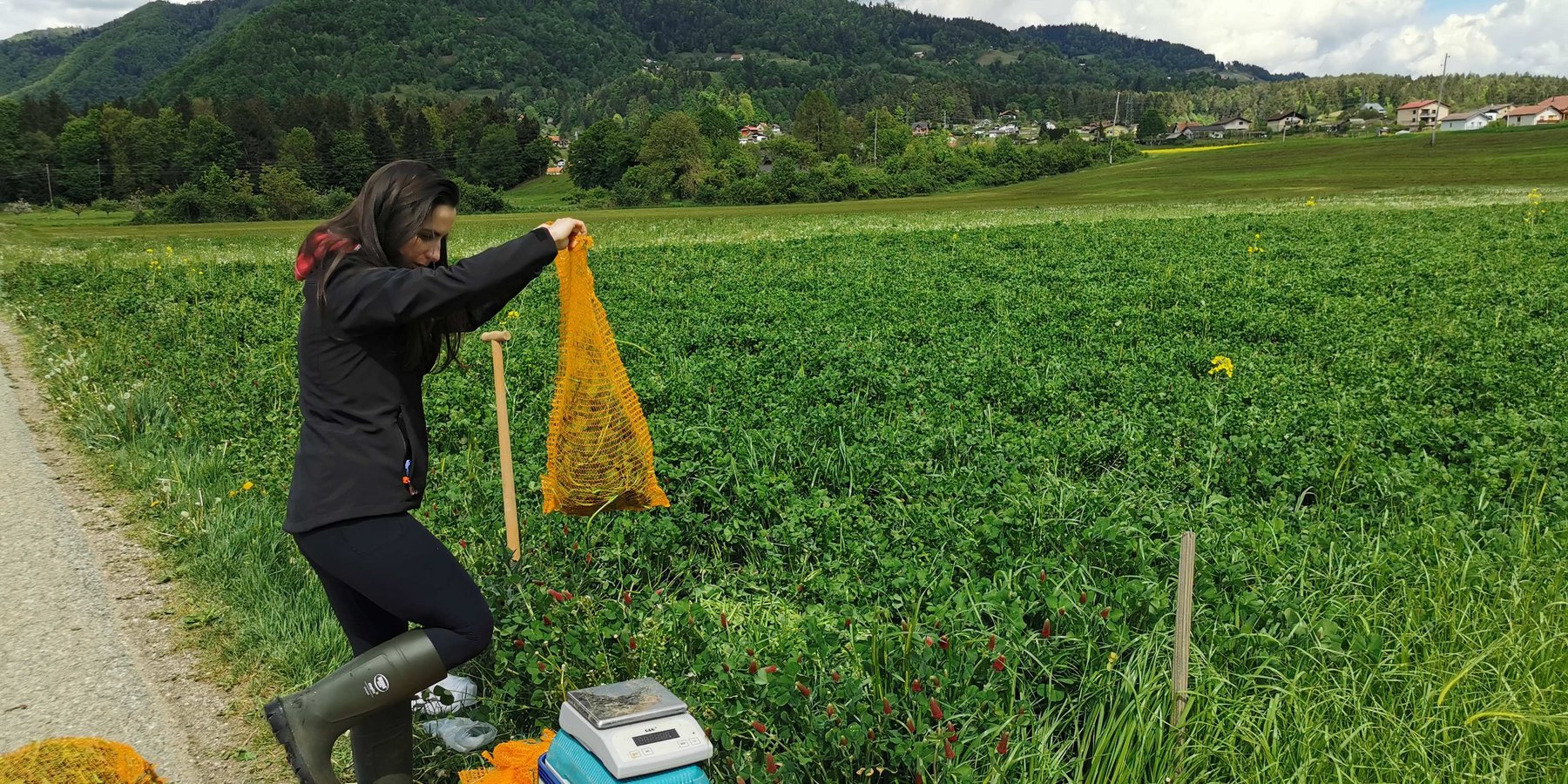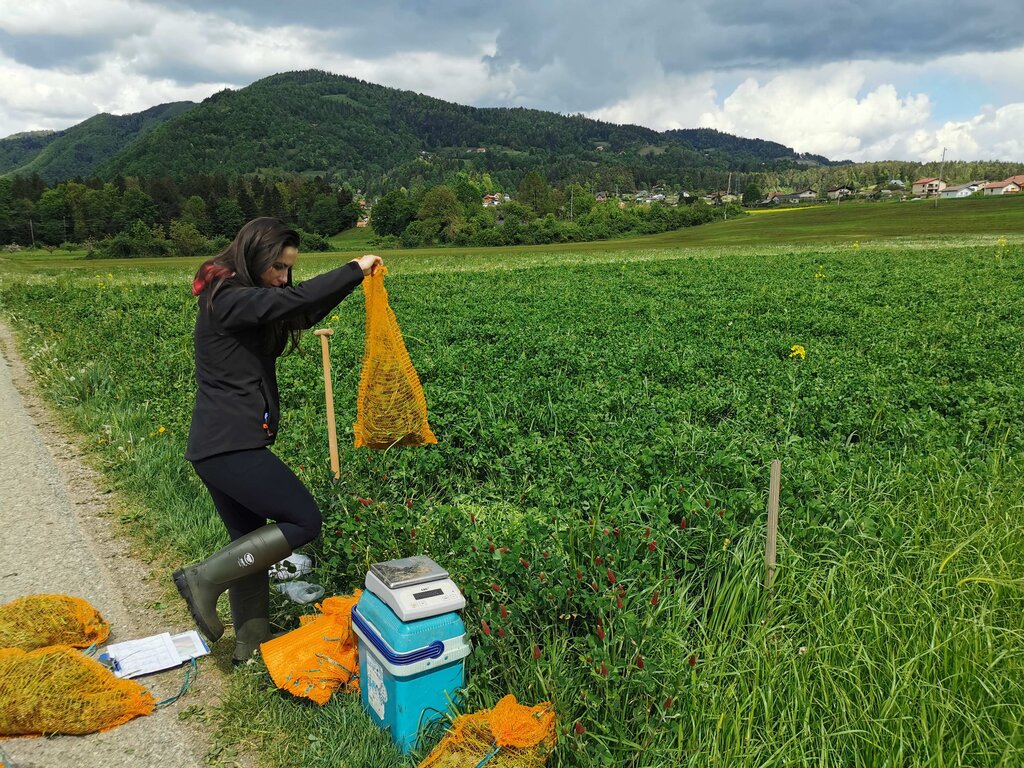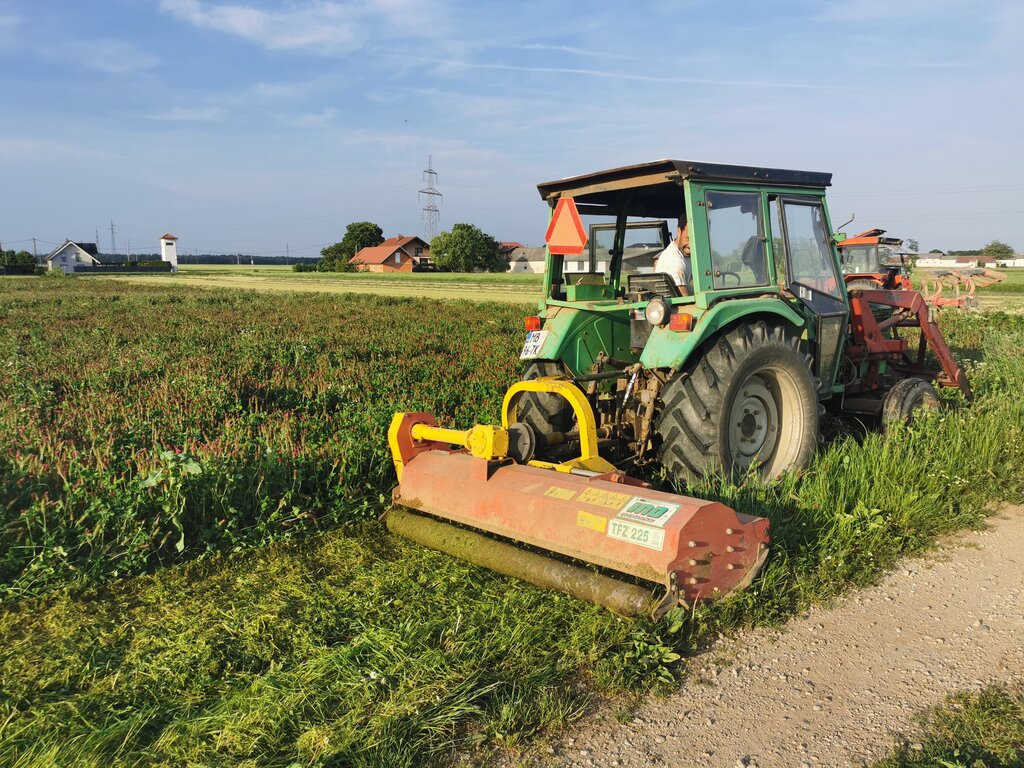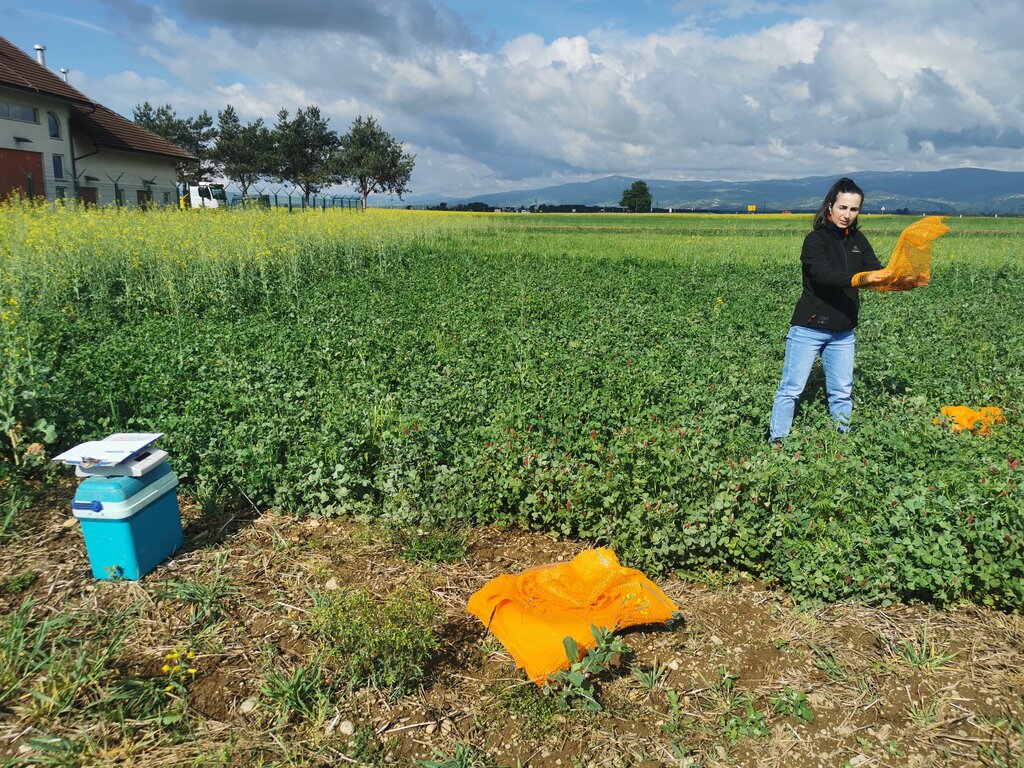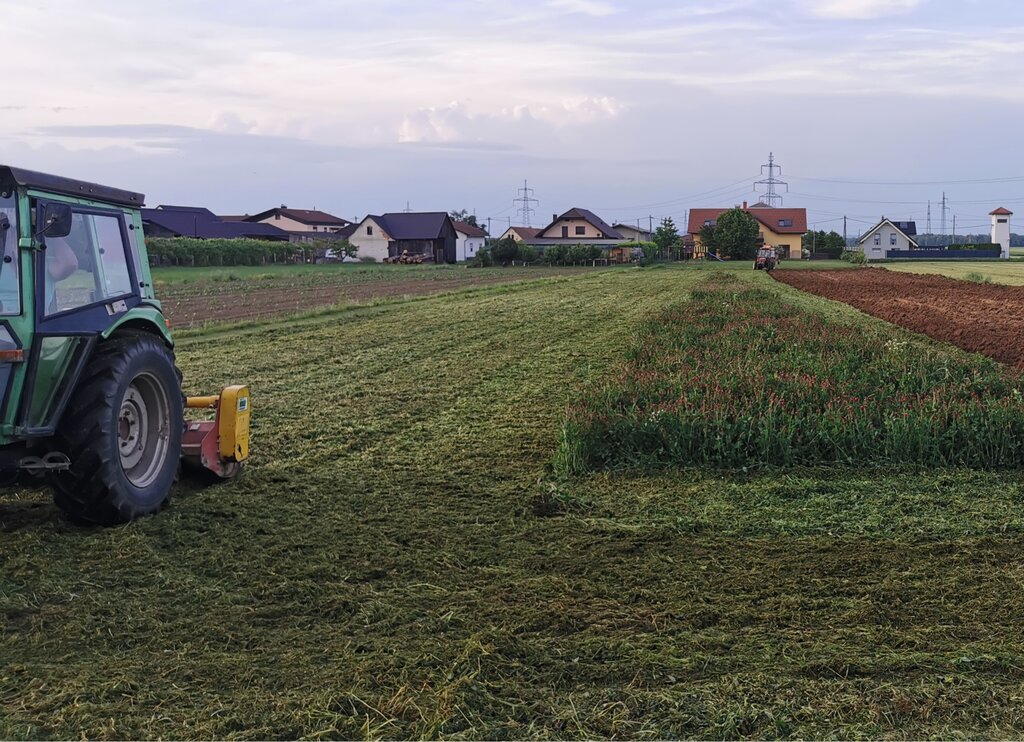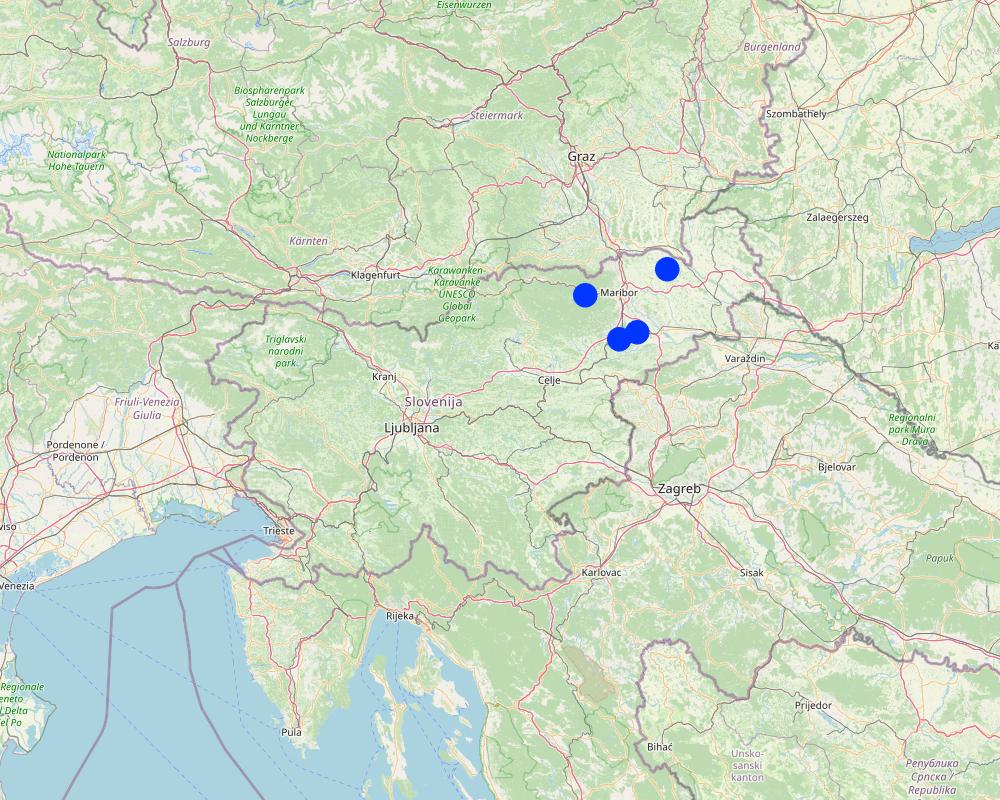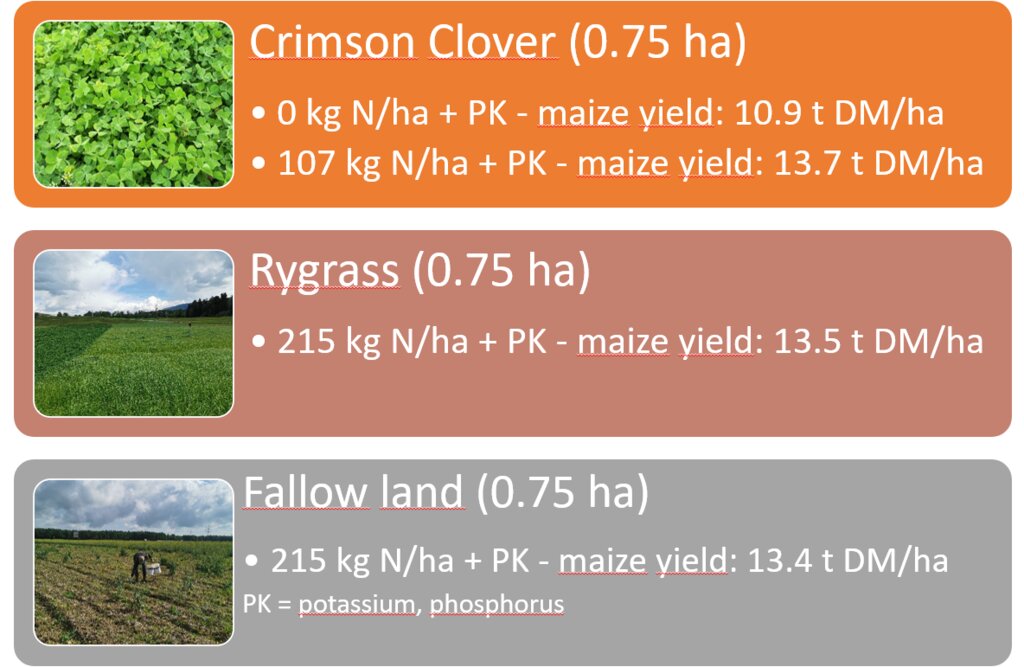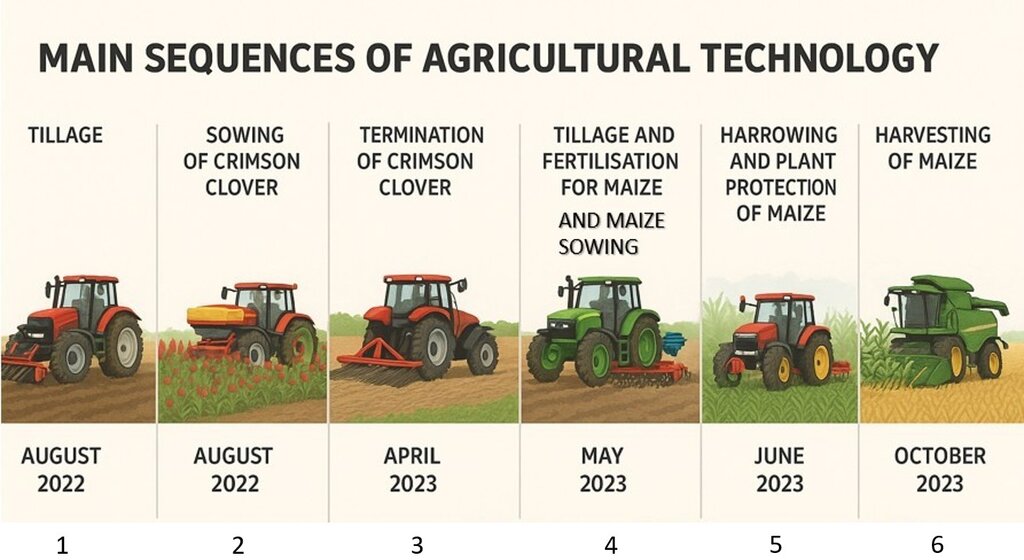Crimson clover as an overwintering cover crop for nitrogen supply [ប្រទេសស្លូវេនី]
- ការបង្កើត៖
- បច្ចុប្បន្នភាព
- អ្នកចងក្រង៖ Tamara Korošec
- អ្នកកែសម្រួល៖ Gregor Kramberger
- អ្នកត្រួតពិនិត្យច្រើនទៀត៖ William Critchley, Rima Mekdaschi Studer
Inkarnatka kot prezimni dosevek za oskrbo z dušikom
technologies_7507 - ប្រទេសស្លូវេនី
ពិនិត្យមើលគ្រប់ផ្នែក
ពង្រីកមើលទាំងអស់ បង្រួមទាំងអស់1. ព័ត៌មានទូទៅ
1.2 ព័ត៌មានលម្អិតពីបុគ្គលសំខាន់ៗ និងស្ថាប័នដែលចូលរួមក្នុងការវាយតម្លៃ និងចងក្រងឯកសារនៃបច្ចេកទេស
ឈ្មោះគម្រោងដែលបានចងក្រងឯកសារ/ វាយតម្លៃលើបច្ចេកទេស (បើទាក់ទង)
Integration of cover crops into field crop rotation - Slovenia (EIP-AGRI)ឈ្មោះអង្គភាពមួយ (ច្រើន) ដែលបានចងក្រងឯកសារ/ វាយតម្លៃបច្ចេកទេស (បើទាក់ទង)
Chamber of Agriculture and Forestry of Slovenia – Institute of Agriculture and Forestry Maribor (KGZS) - ប្រទេសស្លូវេនី1.3 លក្ខខណ្ឌទាក់ទងទៅនឹងការប្រើប្រាស់ទិន្នន័យដែលបានចងក្រងតាមរយៈ វ៉ូខេត
អ្នកចងក្រង និង(បុគ្គលសំខាន់ៗ)យល់ព្រមទទួលយកនូវលក្ខខណ្ឌនានាទាក់ទងទៅនឹងការប្រើប្រាស់ទិន្នន័យដែលបានចងក្រងតាមរយៈវ៉ូខេត:
បាទ/ចា៎
1.4 សេចក្តីប្រកាសស្តីពីចីរភាពនៃការពណ៌នាពីបច្ចេកទេស
តើបច្ចេកទេសដែលបានពណ៌នានេះមានបញ្ហាដែលផ្តោតលើការធ្លាក់ចុះគុណភាពដី, បើដូច្នេះវាមិនអាចត្រូវបានប្រកាសថាជាបច្ចេកទេសនៃការគ្រប់គ្រងប្រកបដោយចីរភាពទេ?
ទេ
2. ការពណ៌នាពីបច្ចេកទេស SLM
2.1 ការពណ៌នាដោយសង្ខេបពីបច្ចេកទេស
និយមន័យបច្ចេកទេស:
Crimson clover, overwintered as a cover crop, forms a symbiotic relationship with nitrogen-fixing bacteria, capturing nitrogen and thus enriching the soil. This helps reduce the need for synthetic fertilizers and aids in soil erosion control, weed suppression, and improved soil structure.
2.2 ការពណ៌នាលម្អិតពីបច្ចេកទេស
ការពណ៌នា:
Crimson clover (Trifolium incarnatum) is a winter annual legume used as a cover crop for nitrogen fixation, erosion control, and soil improvement. It is well suited to mild winter climates and can be integrated into various farming systems. It can be sown alone or in mixtures after the main crop is harvested. It covers the soil from late summer until spring and can be used as fodder or for green manure.
Its key function is nitrogen fixation through the help of nitrogen-fixing bacteria (Rhizobium). Through the winter it protects the soil from erosion, prevents nutrient leaching, and helps suppress weeds. The deep root system improves soil aeration and drainage. When terminated, it adds organic matter and nutrients to the soil, and its nectar-rich flowers attract pollinators and provide a habitat for beneficial predatory insects.
Crimson clover is often included in multi-year crop rotations. Activities include light tillage or no-till. Sowing usually takes place in late August to early September - or at least 6 to 8 weeks before the first frost. Fertilization with mineral nitrogen is not required, but phosphorus and potassium can help in establishment. Minimal maintenance is needed as these plants suppress weeds and reduce pests, but some fungal diseases may occur in wet conditions. Termination involves mowing or rolling at 50% bloom and then herbicides, or it can be incorporated as green manure.
Farmers value crimson clover for its multiple benefits including cost savings from reduced fertilizer use. Livestock farmers use it for forage. Some challenges may arise in colder climates, and when the soil is wet or compacted.
Under trials, the use of crimson clover as a cover crop to supply nitrogen was compared with a ryegrass cover crop and with fallow land, where no cover crops were used. The seeds were sown during two periods—early (August) and late (September)—and the cover crops were not further fertilized. The cover crops were terminated before sowing maize. The fallow area and the ryegrass area were fertilized according to the requirements of maize (215 kg N/ha) and soil analysis (for P and K). Half of the crimson clover area received no N fertilization, and the other half received only half of the required N. The maize crop was monitored by measuring soil, maize growth, grain yield, whole plant weight, and root weight. Crimson clover contributed between 61.6 and 78.6 kg of symbiotically fixed N ha⁻¹. The total soil amount of N accumulated by crimson clover was 100.7 kg N ha⁻¹, twice as much as under Italian ryegrass. The maize grain yields were significantly the lowest (10.9 t DM grain ha⁻¹) where crimson clover was sown early and the maize received no additional N. When crimson clover was used and maize was fertilized with half the N rate, grain yields were equivalent to those obtained on plots that received the full N rate (Italian ryegrass 13.5 t DM ha⁻¹, and the bare fallow control 13.4 t DM ha⁻¹).
2.3 រូបភាពនៃបច្ចេកទេស
2.5 ប្រទេស/តំបន់/ទីតាំងកន្លែង ដែលបច្ចេកទេសត្រូវបានអនុវត្ត និងបានគ្រប់ដណ្តប់ដោយការវាយតម្លៃនេះ
ប្រទេស:
ប្រទេសស្លូវេនី
តំបន់/រដ្ឋ/ខេត្ត:
Podravje
បញ្ជាក់បន្ថែមពីលក្ខណៈនៃទីតាំង:
Selnica ob Dravi, Cirkovce, Pragersko
បញ្ជាក់ពីការសាយភាយនៃបច្ចេកទេស:
- ត្រូវបានផ្សព្វផ្សាយត្រឹមតំបន់មួយ
ប្រសិនបើមិនច្បាស់ពីទំហំផ្ទៃដី សូមធ្វើការប៉ាន់ប្រម៉ាណ:
- < 0.1 គម2 (10 ហិកតា)
តើបច្ចេកទេស (មួយ ឬច្រើន) ទាំងនោះស្ថិតនៅក្នុងតំបន់ការពារជាអចិន្ត្រៃយ៍ណាមួយដែរឬទេ?
ទេ
មតិយោបល់:
The technology is spread throughout arable land in Slovenia. The trial was conducted only on six farms in Podravje region .
Map
×2.6 កាលបរិច្ឆេទនៃការអនុវត្ត
បង្ហាញឆ្នាំនៃការចុះអនុវត្ត:
2024
2.7 ការណែនាំពីបច្ចេកទេស
សូមបញ្ជាក់តើបច្ចេកទេសត្រូវបានណែនាំឱ្យអនុវត្តដោយរបៀបណា:
- តាមរយៈការបង្កើតថ្មីរបស់អ្នកប្រើប្រាស់ដី
- ពេលកំពុងពិសោធន៍
- តាមរយៈគម្រោង / អន្តរាគមន៍ពីខាងក្រៅ
មតិយោបល់ (ប្រភេទនៃគម្រោង ។ល។):
The European Innovation Partnership (EIP) projects for agricultural productivity and sustainability (EIP-AGRI) enable exchange of knowledge for agriculture, forestry, and rural areas. The technology was introduced on these farms through the EIP project: "Integration of Cover Crops in Crop Rotation – Possibilities for Replacing Nitrogen from Mineral Fertilizers in Fertilization of the Next Crop"
3. ចំណាត់ថ្នាក់នៃបច្ចេកទេស SLM
3.1 គោលបំណងចម្បង (១ ឬច្រើន) នៃបច្ចេកទេសនេះ
- ធ្វើឱ្យប្រសើរឡើងនូវផលិតកម្ម
- កាត់បន្ថយ, បង្ការ, ស្តារឡើងវិញនូវការធ្លាក់ចុះគុណភាពដី
- អភិរក្ស/ធ្វើឱ្យប្រសើរឡើងជីវចម្រុះ
- បន្ស៊ាំទៅនឹងការប្រែប្រួលអាកាសធាតុ/គ្រោះមហន្តរាយ និងផលប៉ះពាល់របស់វា
- បង្កើតផលប្រយោជន៍សេដ្ឋកិច្ច
3.2 ប្រភេទដីប្រើប្រាស់មួយប្រភេទ (ច្រើនប្រភេទ) ដែលបានអនុវត្តបច្ចេកទេស
ដីប្រើប្រាស់ចម្រុះនៅលើដីតែមួយ:
ទេ
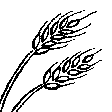
ដីដាំដំណាំ
- ដំណាំប្រចាំឆ្នាំ
ដំណាំប្រចាំឆ្នាំ - បញ្ជាក់ប្រភេទដំណាំ:
- ធញ្ញជាតិ - ពោត
ប្រព័ន្ធដាំដុះដំណាំប្រចាំឆ្នាំ:
ពោត/sorghum/millet legume
ចំនួនសារដែលដាំដំណាំក្នុងមួយឆ្នាំ:
- 1
តើជាការអនុវត្តន៍ដំណាំចន្លោះ?
ទេ
តើជាការអនុវត្តន៍ដំណាំវិលជុំ?
បាទ/ចា៎
បើបាទ/ច៎ា សូមបញ្ជាក់:
5 year crop rotation: 3 different main crops in 5 years, plus cover crops after spring crops
3.3 បន្ទាប់ពីអនុវត្តបច្ចេកទេស តើដីប្រើប្រាស់មានការប្រែប្រួលដែររឺទេ?
បន្ទាប់ពីអនុវត្តបច្ចេកទេស តើដីប្រើប្រាស់មានការប្រែប្រួលដែររឺទេ?
- ទេ (បន្តទៅសំណួរ 3.4)
3.4 ការផ្គត់ផ្គង់ទឹក
ការផ្គត់ផ្គង់ទឹកនៅកន្លែងអនុវត្តបច្ចេកទេស:
- ទឹកភ្លៀង
3.5 ក្រុម SLM ដែលបច្ចេកទេសស្ថិតនៅក្នុង
- ធ្វើឱ្យប្រសើរឡើងគម្របដី/ ដំណាំគម្របដី
- ការគ្រប់គ្រងជីជាតិដីតាមបែបចម្រុះ
3.6 វិធានការ SLM ដែលបញ្ចូលនូវបច្ចេកទេស
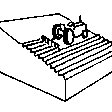
វិធានការក្សេត្រសាស្ត្រ
- A1: ដំណាំ/គម្របដី
- A2: សារធាតុសរីរាង្គ/ជីជាតិដី
3.7 កំណត់ប្រភេទនៃការធ្លាក់ចុះគុណភាពដីសំខាន់ៗដែលបច្ចេកទេសនេះបានដោះស្រាយ
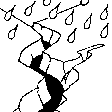
ការហូរច្រោះដីដោយសារទឹក
- Wt: ការបាត់ដីស្រទាប់លើដោយការហូរច្រោះ
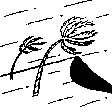
ការបាត់ដីដោយសារខ្យល់
- Et: ការបាត់បង់ដីស្រទាប់លើ
មតិយោបល់:
Although primary cause of technology is natural nitrogen supply, the technology indirectly addressed also the soul erosion.
3.8 ការពារ កាត់បន្ថយ ឬស្តារឡើងវិញនៃការធ្លាក់ចុះគុណភាពដី
បញ្ជាក់ពីគោលដៅរបស់បច្ចេកទេស ដែលផ្តោតទៅការធ្លាក់ចុះគុណភាពដី:
- ការការពារការធ្លាក់ចុះគុណភាពដី
4. បច្ចេកទេសជាក់លាក់ សកម្មភាពអនុវត្ត ធាតុចូល និងថ្លៃដើម
4.1 គំនូសបច្ចេកទេសនៃបច្ចេកទេសនេះ
លក្ខណៈពិសេសនៃបច្ចេកទេស (ទាក់ទងនឺងគំនូរបច្ចេកទេស):
The technology of using crimson clover as a cover crop (variety 'Bolsena') to supply nitrogen was compared with the ryegrass cover crop (variety 'Turtetra') and fallow land, where no cover crops were used. Each plot covered area of 0.75 ha. The seeds were sown during two testing periods—early (August) and late (September)—and the cover crops were not further fertilized. The cover crops were terminated through mulching or ploughing before sowing the main crop, which was maize. The fallow area and the ryegrass area were fertilized according to the maize's requirements (215 kg N/ha) and soil analysis (phosphorus, P; potassium, K). Half of the area with crimson clover received no nitrogen fertilization, and the other half received only half of the required nitrogen (107 kg N/ha). The maize crop was monitored throughout the growing season by measuring soil nitrogen and assessing maize growth.
ឈ្មោះអ្នកនិពន្ធ:
Tamara Korošec
កាលបរិច្ឆេទ:
03/03/2025
លក្ខណៈពិសេសនៃបច្ចេកទេស (ទាក់ទងនឺងគំនូរបច្ចេកទេស):
Main sequences of the technology: 1. tillage and seed bed preparation (disc cultivator or similar) for sowing cover crop (crimson clover) after the winter cereals harvest (August 2022); 2. sowing of crimson clover is usually combined with tillage, or done separately (August 2022); 3. mechanical termination of crimson clover (April 2023), 4. tillage, fertilisation, seed bed preparation and sowing of maize (may 2023), 5. harrowing and plant protection (herbicide) of maize (June 2023), 6. harvesting of maize (October 2023).
ឈ្មោះអ្នកនិពន្ធ:
Tamara Korošec (made with Chat GPT)
កាលបរិច្ឆេទ:
30/09/2025
4.2 ព័ត៌មានទូទៅដែលពាក់ព័ន្ធនឹងការគណនាធាតុចូល និងថ្លៃដើម
កំណត់របៀបនៃការគណនាថ្លៃដើម និងធាតុចូល:
- ក្នុងតំបន់អនុវត្តបច្ចេកទេស
កំណត់ទំហំ និងឯកត្តាផ្ទៃដី:
ha
ផ្សេងៗ/ រូបិយប័ណ្ណជាតិ (បញ្ជាក់):
EUR
បើពាក់ព័ន្ធសូមកំណត់អត្រាប្តូរប្រាក់ពីដុល្លាទៅរូបិយប័ណ្ណតំបន់ (ឧ. 1 ដុល្លារ = 79.9 រៀលនៃរូបិយប័ណ្ណប្រេស៊ីល) ៖ 1 ដុល្លារ =:
0,85
4.3 សកម្មភាពបង្កើត
មតិយោបល់:
None
4.4 ថ្លៃដើម និងធាតុចូលដែលត្រូវការសម្រាប់ការបង្កើតបច្ចេកទេស
មតិយោបល់:
None
4.5 សកម្មភាពថែទាំ
| សកម្មភាព | ពេលវេលា/ ភាពញឹកញាប់ | |
|---|---|---|
| 1. | Stubble preparation (tillage) for crimson clover + sowing (stages 1 and 2 in diagram) | August (or September) |
| 2. | Mechanical cover crop termination and soil preparation before maize sowing (stage 3 in diagram) | end of April |
| 3. | Sowing of maize (stage 4 in diagram) | May |
| 4. | Fertilisation (part of stage 4 in diagram) | May, June |
| 5. | Hoeing and weed control (herbicide) (stage 5 in diagram) | May, June |
| 6. | Harvest (maize) (stage 6 in diagram) | October |
| 7. | Drying (maize) (part of stage 6 in diagram) | October |
4.6 កំណត់ថ្លៃដើមសម្រាប់ការថែទាំ/ សកម្មភាពរបស់បច្ចេកទេស (ក្នុងរយៈពេលមួយឆ្នាំ)
| បញ្ជាក់ពីធាតុចូល | ឯកតា | បរិមាណ | ថ្លៃដើមក្នុងមួយឯកតា | ថ្លៃធាតុចូលសរុប | % នៃថ្លៃដើមដែលចំណាយដោយអ្នកប្រើប្រាស់ដី | |
|---|---|---|---|---|---|---|
| កម្លាំងពលកម្ម | All labour costs | hour | 6,0 | 15,0 | 90,0 | 100,0 |
| សម្ភារៈ | Stubble preparation for crimson clover (tillage) | ha | 1,0 | 50,0 | 50,0 | 100,0 |
| សម្ភារៈ | Sowing of crimson clover | ha | 1,0 | 46,3 | 46,3 | 100,0 |
| សម្ភារៈ | Mechanical termination of the crimson clover | ha | 1,0 | 37,5 | 37,5 | 100,0 |
| សម្ភារៈ | Tillage and seed bed preparation for maize | ha | 1,0 | 60,0 | 60,0 | 100,0 |
| សម្ភារៈ | Maize sowing | ha | 1,0 | 60,0 | 60,0 | 100,0 |
| សម្ភារៈ | Maize hoeing and weed control | ha | 1,0 | 60,0 | 60,0 | 100,0 |
| សម្ភារៈ | Maize harvesting | ha | 1,0 | 140,0 | 140,0 | 100,0 |
| សម្ភារៈដាំដុះ | Crimson clover seed | ha | 28,0 | 3,5 | 98,0 | 100,0 |
| សម្ភារៈដាំដុះ | Maize seed | ha | 1,0 | 290,0 | 290,0 | 100,0 |
| ជី និងសារធាតុពុល | Fertilizer | ha | 1,0 | 150,0 | 150,0 | 100,0 |
| ជី និងសារធាតុពុល | Herbicide | ha | 1,0 | 80,0 | 80,0 | 100,0 |
| ផ្សេងៗ | Drying of maize grain | all harvest | 1,0 | 428,0 | 428,0 | 100,0 |
| ថ្លៃដើមសរុបសម្រាប់ការថែទាំដំណាំតាមបច្ចេកទេស | 1589,8 | |||||
| ថ្លៃដើមសរុបសម្រាប់ការថែទាំដំណាំតាមបច្ចេកទេសគិតជាដុល្លារ | 1870,35 | |||||
ប្រសិនបើមិនអាចបំបែកតម្លៃដើមក្នុងតារាងខាងក្រោមទេ សូមផ្តល់នូវតម្លៃប៉ាន់ស្មានសរុបក្នុងការថែទាំបច្ចេកទេសនោះ:
1561,8
មតិយោបល់:
The above calculation is for combination of crimson clover cover crop and half the amount of nitrogen fertilizer (107 kg/ha) for maize production. This technology had similar grain production (13.7 t/ha) as full application of mineral nitrogen (215 kg/ha) with combination of fallow land or ryegrass as cover crop. The revenue for this technology from selling the grain was 2877 €/ha (0.21 €/kg). Crimson clover with no additional mineral fertilisation for maize had significantly lower yields (10.9 t/ha) and thus lower revenue per hectare (2289 €/ha; 0.21 €/kg of grain). For crops which need less nitrogen than corn, the additional mineral N fertilisation would not be necessary and so costs would be lower. Farmers get 180 € of basic subsidies per ha and further 148 € per ha for greening through the winter (EU CAP).
4.7 កត្តាសំខាន់បំផុតដែលមានឥទ្ធិពលដល់ការចំណាយ
ពណ៌នាពីកត្តាប៉ះពាល់ចម្បងៗទៅលើថ្លៃដើម:
Most important factors affecting the costs are the price of seeds and machinery hours.
5. លក្ខណៈបរិស្ថានធម្មជាតិ និងមនុស្ស
5.1 អាកាសធាតុ
បរិមាណទឹកភ្លៀងប្រចាំឆ្នាំ
- < 250 មម
- 251-500 មម
- 501-750 មម
- 751-1,000 មម
- 1,001-1,500 មម
- 1,501-2,000 មម
- 2,001-3,000 មម
- 3,001-4,000 មម
- > 4,000 មម
បញ្ជាក់ឈ្មោះឯកសារយោងនៃស្ថានីយឧតុនិយម:
ARSO - Environmental Agency of Republic of Slovenia, archive data (last 10 years) for main station in Podravje region - Letališče Edvarda Rusjana Maribor
តំបន់កសិអាកាសធាតុ
- មានភ្លៀងមធ្យម
Continental Climate (Central and Northeastern Slovenia). Meteo station Letališče Edvarada Rusjana Maribor:
Cold winters and hot summers. The average yearly temperature (last 10 years) is 11.5 degrees C.
Large temperature fluctuations between seasons. Average maximal temperature 16.7 degrees C. , the average minimal temperature is 6.4 degrees C. Absolute max. temperature (ave 10 years) was 34 degrees C, and the average absolute minimal temperature approximately -10 degrees.
5.2 សណ្ឋានដី
ជម្រាលជាមធ្យម:
- រាបស្មើ (0-2%)
- ជម្រាលតិចតួច (3-5%)
- មធ្យម (6-10%)
- ជម្រាលខ្ពស់បន្តិច (11-15%)
- ទីទួល (16-30%)
- ទីទួលចោត (31-60%)
- ទីទួលចោតខ្លាំង (>60%)
ទម្រង់ដី:
- ខ្ពង់រាប
- កំពូលភ្នំ
- ជម្រាលភ្នំ
- ជម្រាលទួល
- ជម្រាលជើងភ្នំ
- បាតជ្រលងភ្នំ
តំបន់តាមរយៈកម្ពស់ :
- 0-100 ម
- 101-500 ម
- 501-1,000 ម
- 1,001-1,500 ម
- 1,501-2,000 ម
- 2,001-2,500 ម
- 2,501-3,000 ម
- 3,001-4,000 ម
- > 4,000 ម
បញ្ជាក់ថាតើបច្ចេកទេសនេះត្រូវបានអនុវត្តន៍នៅក្នុង:
- មិនពាក់ព័ន្ធទាំងអស់
5.3 ដី
ជម្រៅដីជាមធ្យម:
- រាក់ខ្លាំង (0-20 សម)
- រាក់ (21-50 សម)
- មធ្យម (51-80 សម)
- ជ្រៅ (81-120 សម)
- ជ្រៅខ្លាំង (> 120 សម)
វាយនភាពដី (ស្រទាប់លើ):
- មធ្យម (ល្បាយ, ល្បាប់)
វាយនភាពដី (> 20 សម ស្រទាប់ក្នុង):
- មធ្យម (ល្បាយ, ល្បាប់)
សារធាតុសរីរាង្គនៅស្រទាប់ដីខាងលើ:
- ខ្ពស់ (>3%)
បើអាចសូមភ្ជាប់ការពណ៌នាពីដីឱ្យបានច្បាស់ ឬព័ត៌មានដែលអាចទទួលបាន ឧ. ប្រភេទដី, pH ដី/ ជាតិអាស៊ីត, សមត្ថភាពផ្លាស់ប្តូរកាចុង, វត្តមាននីត្រូសែន, ភាពប្រៃ ។ល។:
The test fields were on different soil types:
- Eutric alluvial soils pH 6,6-7,2
- Dystric brown soils on non calcareous sandy gravel sediments, pH4,6-5,5
- Eutric brown soils on alluvial-colluvial sediments and deluvium, pH 5,6-6,5
5.4 ទឹកដែលអាចទាញមកប្រើប្រាស់បាន និងគុណភាពទឹក
នីវ៉ូទឹកក្រោមដី:
5-50 ម
ទឹកលើដីដែលអាចទាញយកប្រើប្រាស់បាន:
ល្អ
គុណភាពទឹក (មិនបានធ្វើប្រត្តិកម្ម):
ទឹកពិសារដែលគ្មានគុណភាព (តម្រូវឱ្យមានការសំអាត)
គុណភាពទឹក គឺផ្តោតទៅលើ៖:
ទឹកក្រោមដី
តើមានបញ្ហាភាពទឹកប្រៃហូរចូលមកដែរឬទេ?
ទេ
តើទឹកជំនន់កំពុងកើតមាននៅតំបន់នេះដែររឺទេ?
ទេ
មតិយោបល់ និងលក្ខណៈពិសេសផ្សេងៗទៀតលើគុណភាព និងបរិមាណទឹក :
In Slovenia all drinking water is treated by chlorine. If we compare it to the rest of the world, we have good drinking water, but we never use it untreated.
5.5 ជីវៈចម្រុះ
ភាពសម្បូរបែបនៃប្រភេទ:
- ខ្ពស់
ភាពសម្បូរបែបនៃទីជម្រក:
- កម្រិតមធ្យម
មតិយោបល់ និងលក្ខណៈពិសេសផ្សេងទៀតលើជីវចម្រុះ:
Under the cover crop area soil biodiversity is high. Regarding overall habitat, the test areas are in intensive agricultural areas, that is why the habitat biodiversity which is otherwise high in Slovenia, is rated as moderate.
5.6 លក្ខណៈនៃអ្នកប្រើប្រាស់ដីដែលអនុវត្តបច្ចេកទេស
នៅមួយកន្លែង ឬពនេចរ :
- នៅមួយកន្លែង
ទីផ្សារនៃប្រព័ន្ធផលិតកម្ម:
- ពាក់កណ្តាលពាណិជ្ជកម្ម (ផ្គត់ផ្គង់ខ្លួនឯង/ ពាណិជ្ជកម្ម)
- ពាណិជ្ជកម្ម/ ទីផ្សារ
ចំណូលក្រៅកសិកម្ម:
- 10-50% នៃចំណូល
កម្រិតជីវភាព:
- មធ្យម
ឯកជន ឬក្រុម:
- ធ្វើខ្លួនឯង/ គ្រួសារ
កម្រិតប្រើប្រាស់គ្រឿងយន្ត:
- គ្រឿងយន្ត/ ម៉ាស៊ីន
យេនឌ័រ:
- បុរស
អាយុរបស់អ្នកប្រើប្រាស់ដី:
- វ័យកណ្តាល
5.7 ទំហំផ្ទៃដីជាមធ្យមនៃដីប្រើប្រាស់ដោយអ្នកប្រើប្រាស់ដី ក្នុងការអនុវត្តបច្ចេកទេស
- < 0.5 ហិកតា
- 0.5-1 ហិកតា
- 1-2 ហិកតា
- 2-5 ហិកតា
- 5-15 ហិកតា
- 15-50 ហិកតា
- 50-100 ហិកតា
- 100-500 ហិកតា
- 500-1,000 ហិកតា
- 1,000-10,000 ហិកតា
- > 10,000 ហិកតា
តើផ្ទៃដីនេះចាត់ទុកជាទំហំកម្រិតណាដែរ ខ្នាតតូច មធ្យម ឬខ្នាតធំ (ធៀបនឹងបរិបទតំបន់)?
- ខ្នាតមធ្យម
5.8 ភាពជាម្ចាស់ដី កម្មសិទ្ធប្រើប្រាស់ដី និងកម្មសិទ្ធប្រើប្រាស់ទឹក
ភាពជាម្ចាស់ដី:
- រដ្ឋ
- ឯកជន មានកម្មសិទ្ធ
កម្មសិទ្ធិប្រើប្រាស់ដី:
- កិច្ចសន្យាជួល
- ឯកជន
កម្មសិទ្ធប្រើប្រាស់ទឹក:
- ជាក្រុម (មានដែនកំណត់)
- កិច្ចសន្យាជួល
តើកម្មសិទ្ធប្រើប្រាស់ដី គឺផ្អែកលើប្រព័ន្ធច្បាប់បែបបុរាណ?
ទេ
សូមបញ្ជាក់:
Land use rights in Slovenia are primarily based on modern statutory law, not traditional or customary law. The main frameworks are the Constitution of the Republic of Slovenia, the Law of Property Code (Stvarnopravni zakonik, SPZ), the Agricultural Land Act (Zakon o kmetijskih zemljiščih, ZKZ), and the Spatial Planning and Building Acts (Zakon o urejanju prostora, Gradbeni zakon, etc.).
5.9 ការប្រើប្រាស់សេវាកម្ម និងហេដ្ឋារចនាសម្ព័ន្ធ
សុខភាព:
- មិនល្អ
- មធ្យម
- ល្អ
ការអប់រំ:
- មិនល្អ
- មធ្យម
- ល្អ
ជំនួយបច្ចេកទេស:
- មិនល្អ
- មធ្យម
- ល្អ
ការងារ (ឧ. ការងារក្រៅកសិដ្ឋាន):
- មិនល្អ
- មធ្យម
- ល្អ
ទីផ្សារ:
- មិនល្អ
- មធ្យម
- ល្អ
ថាមពល:
- មិនល្អ
- មធ្យម
- ល្អ
ផ្លូវ និងការដឹកជញ្ជូន:
- មិនល្អ
- មធ្យម
- ល្អ
ទឹកផឹក និងអនាម័យ:
- មិនល្អ
- មធ្យម
- ល្អ
សេវាកម្មហិរញ្ញវត្ថុ:
- មិនល្អ
- មធ្យម
- ល្អ
6. ផលប៉ះពាល់ និងការសន្និដ្ឋាន
6.1 ផលប៉ះពាល់ក្នុងបរិវេណអនុវត្តបច្ចេកទេសដែលកើតមាន
ផលប៉ះពាល់លើសេដ្ឋកិច្ចសង្គម
ផលិតផល
ផលិតកម្មដំណាំ
គុណភាពមុន SLM:
215 kg/ha mineral nitrogen for 13.4 t of maize grain
គុណភាពក្រោយ SLM:
107 kg/ha mineral nitrogen for 13.7 t of maize grain
មតិយោបល់/ ការបញ្ជាក់:
increased maize grain yields with less use of nitrogen fertiliser (positive impact)
ចំណូល និងថ្លៃដើម
ការចំណាយលើធាតុចូលកសិកម្ម
គុណភាពមុន SLM:
201 €
គុណភាពក្រោយ SLM:
101 €
មតិយោបល់/ ការបញ្ជាក់:
reduced expenses on mineral fertiliser for 100 kg of N per ha (positive impact)
ផលប៉ះពាល់ទៅលើអេកូឡូស៊ី
វដ្តទឹក/លំហូរ
បរិមាណទឹក
មតិយោបល់/ ការបញ្ជាក់:
improved water retention, filtration, drainage (positive impact)
ដី
សំណើមដី
មតិយោបល់/ ការបញ្ជាក់:
water retention capacity improved (positive impact)
គម្របដី
មតិយោបល់/ ការបញ្ជាក់:
late summer to spring soil cover
ដីប្រេះ
មតិយោបល់/ ការបញ្ជាក់:
lowered soil crusting, which is a positive impact
វដ្តនៃសារធាតុចិញ្ចឹម/ការទទួលបាន
គុណភាពមុន SLM:
0
គុណភាពក្រោយ SLM:
61-150 kg/ha
មតិយោបល់/ ការបញ្ជាក់:
symbiotic nitrogen fixation with crimson clover 61 - 150 kg/ha N fixation (depending on the weather and soil conditions)
សារធាតុសរីរាង្គដី/ការបូនក្រោមដី
មតិយោបល់/ ការបញ្ជាក់:
green manure from cover crops increases soil organic matter
ជីវចម្រុះ៖ ដំណាំ, សត្វ
ដំណាំគម្រប
មតិយោបល់/ ការបញ្ជាក់:
diversified vegetation cover
ភាពសម្បូរបែបនៃទីជំរក
មតិយោបល់/ ការបញ្ជាក់:
increased soil microbial community, diversified crop rotation, benefits for pollinators
ការកាត់បន្ថយហានិភ័យនៃគ្រោះមហន្តរាយ និងគ្រោះអាកាសធាតុ
ផលប៉ះពាល់នៃទឹកជំនន់
មតិយោបល់/ ការបញ្ជាក់:
better drainage
ផលប៉ះពាល់នៃគ្រោះរាំងស្ងួត
មតិយោបល់/ ការបញ្ជាក់:
Lowered evaporation from soil, water retention capacity
ផលប៉ះពាល់នៃព្យុះស៊ីក្លូន/ព្យុះភ្លៀង
មតិយោបល់/ ការបញ្ជាក់:
protection against erosion due to heavy rain storms
បញ្ជាក់ពីការប៉ាន់ស្មាននៃផលប៉ះពាល់ក្នុងបរិវេណអនុវត្តបច្ចេកទេស (វាស់វែង):
On-site impacts included direct field measurements and expert judgements/ predictions on the basis of data from this and previous experiments.
6.2 ផលប៉ះពាល់ក្រៅបរិវេណអនុវត្តបច្ចេកទេសដែលកើតមាន
Buffering/សមត្ថភាពចម្រោះ
មតិយោបល់/ ការបញ្ជាក់:
green cover filters the nutrients that go to the groundwater
វាយតម្លៃផលប៉ះពាល់ក្រៅបរិវេណអនុវត្តបច្ចេកទេស (វាស់វែង):
Off-site impacts are predicted by expert judgements/ predictions on the basis of data from this and previous experiments.
6.3 ភាពប្រឈម និងភាពរួសនៃបច្ចេកទេសទៅនឹងការប្រែប្រួលអាកាសធាតុ និងគ្រោះអាកាសធាតុ/ គ្រោះមហន្តរាយ (ដែលដឹងដោយអ្នកប្រើប្រាស់ដី)
ការប្រែប្រួលអាកាសធាតុ
ការប្រែប្រួលអាកាសធាតុ
| រដូវកាល | កើនឡើង ឬថយចុះ | លក្ខណៈឆ្លើយតបនៃបច្ចេកទេសទៅនឹងការប្រែប្រួលអាកាសធាតុ | |
|---|---|---|---|
| សីតុណ្ហភាពប្រចាំរដូវកាល | រដូវក្តៅ | កើនឡើង | មធ្យម |
| សីតុណ្ហភាពប្រចាំរដូវកាល | រដូវរងា | កើនឡើង | ល្អ |
| បរិមាណទឹកភ្លៀងប្រចាំរដូវកាល | រដូវក្តៅ | ថយចុះ | មិនល្អ |
| បរិមាណទឹកភ្លៀងប្រចាំរដូវកាល | រដូវរងា | ថយចុះ | មធ្យម |
គ្រោះអាកាសធាតុ (មហន្តរាយ)
គ្រោះមហន្តរាយធម្មជាតិ
| លក្ខណៈឆ្លើយតបនៃបច្ចេកទេសទៅនឹងការប្រែប្រួលអាកាសធាតុ | |
|---|---|
| ព្យុះទឹកកកតាមតំបន់ | មធ្យម |
គ្រោះមហន្តរាយអាកាសធាតុ
| លក្ខណៈឆ្លើយតបនៃបច្ចេកទេសទៅនឹងការប្រែប្រួលអាកាសធាតុ | |
|---|---|
| រលកកម្តៅ | មិនល្អ |
| រាំងស្ងួត | មិនល្អ |
គ្រោះមហន្តរាយជីវៈសាស្ត្រ
| លក្ខណៈឆ្លើយតបនៃបច្ចេកទេសទៅនឹងការប្រែប្រួលអាកាសធាតុ | |
|---|---|
| ការមានបញ្ហាសត្វល្អិត/ដង្កូវ | ល្អ |
6.4 ការវិភាគថ្លៃដើម និងអត្ថប្រយោជន៍
តើផលចំណេញ និងការថែទាំ/ ជួសជុលត្រូវបានប្រៀបធៀបគ្នាយ៉ាងដូចម្តេច (ទស្សនៈរបស់អ្នកប្រើប្រាស់ដី)?
រយៈពេលខ្លី:
ប៉ះពាល់តិចតួចបំផុត
រយៈពេលវែង:
វិជ្ជមាន
6.5 ការទទួលយកបច្ចេកទេស
- 1-10%
ក្នុងចំណោមគ្រួសារទាំងអស់ដែលបានអនុវត្តបច្ចេកទេស តើមានប៉ុន្មានគ្រួសារដែលចង់ធ្វើដោយខ្លួនឯង ដោយមិនទទួលបានសម្ភារៈលើកទឹកចិត្ត/ប្រាក់ឧបត្ថម្ភ?:
- 0-10%
មតិយោបល់:
They are mostly motivated by subsidies, so spontaneous adoption is a small percentage.
6.6 ការបន្សុំា
តើថ្មីៗនេះ បច្ចេកទេសនេះត្រូវបានកែតម្រូវដើម្បីបន្ស៊ាំទៅនឹងស្ថានភាពប្រែប្រួលដែរឬទេ?
ទេ
6.7 ភាពខ្លាំង/ គុណសម្បត្តិ/ ឱកាសនៃបច្ចេកទេស
| ភាពខ្លាំង/ គុណសម្បត្តិ/ ឱកាសនៅកន្លែងរបស់អ្នកប្រើប្រាស់ដី |
|---|
| Lower costs for mineral fertilizers, subsidies for seeds |
| Good for soil health |
| Good for water absorption |
| ភាពខ្លាំង/ គុណសម្បត្តិ/ ឱកាស ទស្សនៈរបស់បុគ្គលសំខាន់ៗ |
|---|
| Climate change adaptation |
| Soil improvement - increase in organic matter, soil biodiversity, water capacity |
| Fixation of nitrogen form air, less mineral fertilisers |
6.8 ភាពខ្សោយ/ គុណវិបត្តិ/ ហានិភ័យនៃបច្ចេកទេស និងវិធីសាស្ត្រដោះស្រាយ
| ភាពខ្សោយ/ គុណវិបត្តិ/ ហានិភ័យ ទស្សនៈរបស់អ្នកប្រើប្រាស់ដី | តើបច្ចេកទេសទាំងនោះបានដោះស្រាយបញ្ហាដូចម្តេច? |
|---|---|
| Drought during the seeding of catch crop | earlier or later sowing - however it has an impact anyway |
| Additional work (compared to bare fallow) | combined machinery (soil preparation + sowing combined) |
| Risk of frost if the crimson clover is too big going into winter | sowing and mulching at right time |
| ភាពខ្សោយ/ គុណវិបត្តិ/ ហានិភ័យ ទស្សនៈរបស់អ្នកចងក្រងឬបុគ្គលសំខាន់ៗ | តើបច្ចេកទេសទាំងនោះបានដោះស្រាយបញ្ហាដូចម្តេច? |
|---|---|
| Not applicable for all main crops - early spring crops do not get the same benefits as late spring/summer crops | for early spring crops other nitrogen fixings plants can be used. |
| Nitrogen runoff if no main crop follows after crimson clover destruction | always plant main crop right away |
7. ឯកសារយោង និងវេបសាយ
7.1 វិធីសាស្ត្រ/ ប្រភពនៃព័ត៌មាន
- តាមការចុះទីវាល ការស្រាវជ្រាវនៅទីវាល
regular field visits and monitoring on 4 farms / fileds
- ការសម្ភាសន៍ជាមួយអ្នកប្រើប្រាស់ដី
4 farmers
- ការសម្ភាសន៍ជាមួយអ្នកជំនាញ/ ឯកទេស
consultation with colleagues from the Life science faculty (2)
- ការចងក្រងពីរបាកការណ៍ និងឯកសារផ្សេងៗទៀតដែលមាន
previously prepared reports form the EIP project
មតិយោបល់:
The project was carried out for 2 years. The data were compiled during the whole time - regular monitoring, interviews, sampling...
7.2 ឯកសារយោងដែលបានចេញផ្សាយ
ចំណងជើង អ្នកនិពន្ធ ឆ្នាំ ISBN:
GSELMAN, Anastazija, LISEC, Urška, KOROŠEC, Tamara, PODVRŠNIK, Miran. S prezimnimi metuljnicami do nadomeščanja dušika iz mineralnih gnojil = Winter legumes as a substitute for nitrogen from mineral fertilisers. V: ČEH, Tatjana (ur.), KAPUN, Stanko (ur.). 32. mednarodno znanstveno posvetovanje o prehrani domačih živali [tudi] Zadravčevi-Erjavčevi dnevi 2024 = 32nd International Scientific Symposium on Nutrition of Farm Animals [being] Zadravec-Erjavec Days 2024 : zbornik predavanj = proceedings : Murska Sobota, 14. in 15. november 2024, 14th and 15th November 2024. Murska Sobota: Kmetijsko gozdarska zbornica Slovenije, Kmetijsko gozdarski zavod, 2024. Str. 61-66, graf. prikazi. ISBN 978-961-96187-7-6. [COBISS.SI-ID 215866371]
មានប្រភពមកពីណា? ថ្លៃដើមប៉ុន្មាន?
in various Slovenian libraries - in Slovene
7.3 ការភ្ជាប់ទៅកាន់ព័ត៌មានពាក់ព័ន្ធលើប្រព័ន្ធអនឡាញ
ចំណងជើង/ ពណ៌នា:
Website
វេបសាយ:
https://dosevki.um.si/
7.4 មតិយោបល់ទូទៅ
Just a remark on question formulation: the instructions in section 6.1 appear a bit ambiguous when the response scale for some specific questions appears "reversed" in relation to the guideline parameter - such as "soil crusting" where a negative value is in fact a positive outcome.
ការតភ្ជាប់ និងម៉ូឌុល
ពង្រីកមើលទាំងអស់ បង្រួមទាំងអស់ការតភ្ជាប់
គ្មានការតភ្ជាប់
ម៉ូឌុល
គ្មានម៉ូឌុល


